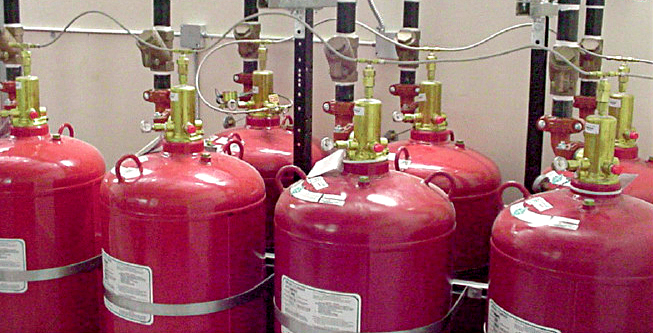There are potential dangers associated with gas cylinders used for gaseous fire suppression systems. These cylinders are different from the cylinders used for industrial and refrigeration gases – and their contents may be hazardous.
Recently, a demolition worker received broken ribs, bruising and punctures after a gas cylinder for a gaseous fire suppression system released its pressure quickly and spun rapidly on the floor before hitting the worker with great force.
These cylinders are fitted with an actuating mechanism that empties the cylinder quickly to extinguish a fire. Once the actuating mechanism has been activated, it cannot be controlled or stopped – and it is not uncommon for these mechanisms to be activated when the cylinders are moved or in transit.
The cylinders are commonly located outside the room they are protecting, which is typically an electrical equipment or computer room.
The actuators operate mechanically, even if electrically disconnected, and the cylinder contains high-pressure gases (from 2000 kPa to 20,000 kPa).
When gases are discharged, an unrestrained cylinder can travel at high speed, spin uncontrollably, penetrate a brick wall – and cause serious injury or death. Also, the gases may be hazardous and can cause asphyxiation, serious health effects or even death.
Unintentional discharge, rapid discharge, hazardous chemicals, high pressure and dangerous missiles are some of the hazards posed by these cylinders.
Action required
- The cylinders should be labelled if they are:
- cylinders that are tall and thin (similar to those used for industrial gases) are high-pressure cylinders (up to 20,000 kPa)
- cylinders that are larger in diameter (and often shorter than industrial gas cylinders) are low-pressure cylinders (up to 2500 kPa)
- The nozzles in the room look different (usually larger) to typical fire sprinklers – and some have several small holes
- The room should have warning signs and warning lights inside and outside
Specific control measures
- Leave the cylinder strapped in place
- Contact a fire service company to de-activate, disconnect and 'make-safe' the cylinder, ready for removal
- Return the cylinder to the fire service company for decanting, re-use or disposal
Don't
- Disconnect the cylinder yourself, either electrically or mechanically
- Release the contents of the cylinder to de-pressurise or empty the cylinder
- Move the cylinder until it is known that it is safe to do so
Further information
For more information on the safe removal of gas cylinders for gaseous fire suppression systems, visit Fire Protection Association Australia.
Back to top